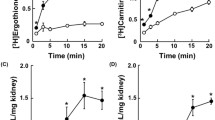Abstract
In order to study the specificity of the contraluminal sulfate transport system the inhibitory potency of salicylate analogs (5 mmol/l each) on the35SO 2−4 influx from the interstitium into cortical tubular cells in situ has been determined. The following was found: 2-hydroxybenzoate (salicylate), per se, did not inhibit contraluminal35SO 2−4 influx. The same holds when an additional NH2-group was introduced in position 4 or 5, or when an additional Cl-group was introduced in position 4. When an additional Cl- or NO2-group was introduced in position 5 a moderate inhibition was seen (app.K i≈4 mmol/l). However, introduction of 2 Cl- or 2 NO2-groups in position 3 and 5 creates compounds with strong inhibitory potency (app.K i≈0.5 mmol/l). 2-hydroxy-3,5-iodobenzoate inhibited too, but with a smaller inhibitory potency (app.K i≈2.3 mmol/l). 2-hydroxybenzoate analogs, which have a carboxy- or sulfo-group in position 5, exerted strong inhibition, those with a acetyl- or butyryl-group exerted moderate inhibition. 1-Naphthol-2-carboxylate did not inhibit, while 1-naphthol-4-sulfamoyl-2-carboxylate did. Amongst the dihydroxybenzoates, 2,3- and 2,5-dihydroxybenzoate did not inhibit contraluminal35SO 2−4 influx, while 2,4- and 2,6-dihydroxybenzoate did. The data indicate that a hydroxy-group in ortho-position and an electro-negative group in the meta-position to the carboxyl group and paraposition to the hydroxy-group are essential for interaction with the contraluminal sulfate transport system. The ability of 2,6-dihydroxybenzoate to inhibit might be explained by its ability to undergo mesomeric conformation.
Similar content being viewed by others
References
Fritzsch G, Haase W, Rumrich G, Fasold H, Ullrich KJ (1984) A stopped flow capillary perfusion method to evaluate contraluminal transport parameters of methylsuccinate from inter-stitium into renal proximal tubular cells. Pflügers Arch 400:250–256
Hansch C, Leo A, Unger SH, Kim KH, Nikaitani D, Lien EJ (1973) “Aromatic” substituent constants for structure activity correlations. J Med Chem 16:1207–1216
Ullrich KJ, Rumrich G, Klöss S (1984) Contraluminal sulfate transport in the proximal tubule of the rat kidney. I. Kinetics, effects of K+, Na+, Ca2+, H+ and anions. Pflügers Arch 402:264–271
Ullrich KJ, Rumrich G, Klöss S (1985) Contraluminal sulfate transport in the proximal tubule of the rat kidney. II. Specificity: sulfate-ester, sulfonates and amino sulfonates. Pflügers Arch 404:293–299
Ullrich KJ, Rumrich G, Klöss (1985) Contraluminal sulfate transport in the tri-carboxylates and sulfocarboxylates. III. Specificity: disulfonates, di- and tri-carboxylates and sulfocarboxylates. Pflügers Arch 404:300–306
Ullrich KJ, Rumrich G, Klöss S, Lang HJ (1985) Contraluminal sulfate transport in the proximal tubule of the rat kidney. V. Specificity: phenolphthaleins, sulfonphthaleins and other sulfo dyes, sulfamoyl-compounds and diphenylamine-2-carboxylates. Pflügers Arch 404:311–318
Author information
Authors and Affiliations
Rights and permissions
About this article
Cite this article
Ullrich, K.J., Rumrich, G. & Klöss, S. Contraluminal sulfate transport in the proximal tubule of the rat kidney. Pflugers Arch. 404, 307–310 (1985). https://doi.org/10.1007/BF00585340
Received:
Accepted:
Issue Date:
DOI: https://doi.org/10.1007/BF00585340




